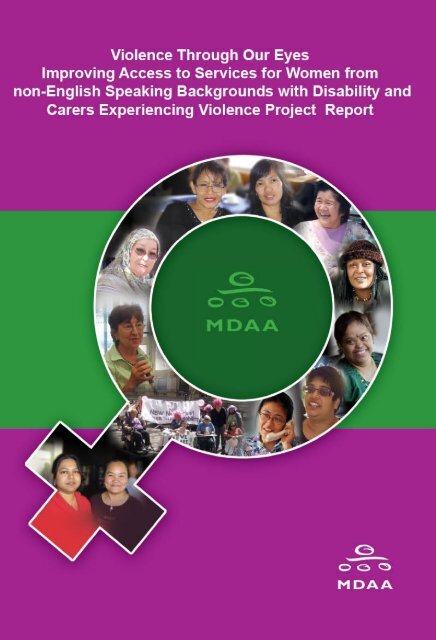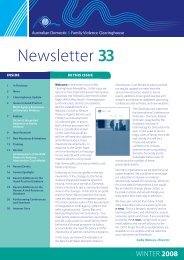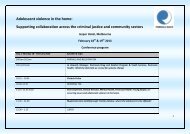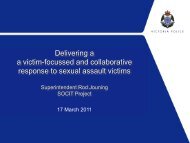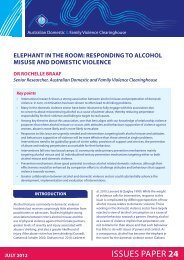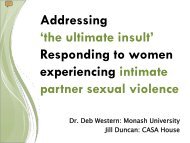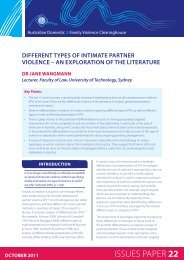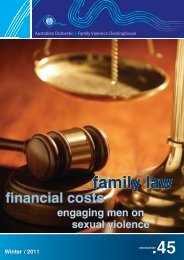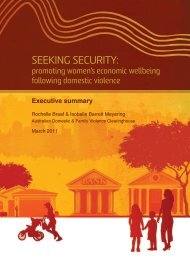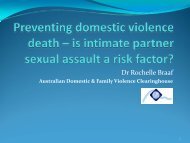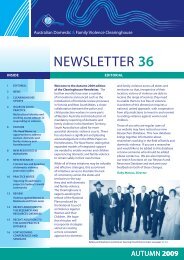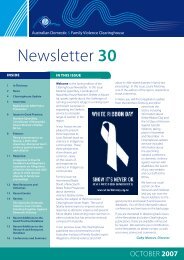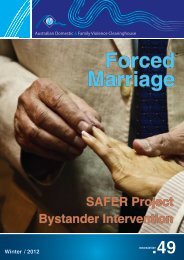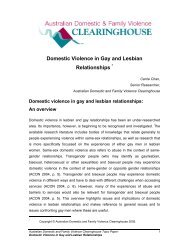Violence through our eyes - Women With Disabilities Australia
Violence through our eyes - Women With Disabilities Australia
Violence through our eyes - Women With Disabilities Australia
You also want an ePaper? Increase the reach of your titles
YUMPU automatically turns print PDFs into web optimized ePapers that Google loves.
Multicultural Disability Advocacy Association of NSW (MDAA)<br />
PO Box 9381<br />
Harris Park NSW 2150<br />
<strong>Australia</strong><br />
Ph. +61 (0)2 9891 6400<br />
Fax: +61 (0)2 9635 5355<br />
Email: mdaa@mdaa.org.au<br />
Website: www.mdaa.org.au<br />
© Multicultural Disability Advocacy Association of NSW<br />
MDAA is a non-profit peak body for people from non-English speaking backgrounds with<br />
disability, their families and carers in NSW.<br />
First published February 2010<br />
ISBN 978-1-920821-23-4<br />
This report is copyright. Non-profit community groups may reproduce any part of the<br />
report, so long as the original meaning is maintained and proper credit is given to the<br />
author and the Multicultural Disability Advocacy Association of NSW. All other persons and<br />
organisations wanting to reproduce material from this report should obtain permission from<br />
the Multicultural Disability Advocacy Association of NSW.
ACKNOWLEDGEMENTS<br />
The Multicultural Disability Advocacy Association of New South Wales (MDAA) gratefully<br />
acknowledges the following contributors.<br />
<strong>Women</strong> from non-English Speaking Backgrounds (NESB) with disability who gave their<br />
time and generously shared their experiences of violence and the barriers they<br />
encountered when trying to access services.<br />
Our partner agencies: Cumberland <strong>Women</strong>’s Health, Immigrant <strong>Women</strong>’s Speakout<br />
Association and NSW Strategy to Reduce <strong>Violence</strong> Against <strong>Women</strong> Unit.<br />
MDAA also appreciates the time and contributions made by the following agencies: Family<br />
Planning NSW; Griffith Sexual Assault Service; Hunter Council of Social Services;<br />
Illawarra Philippino & Multicultural <strong>Women</strong>’s Group INC; Intellectual Disability Rights<br />
Service; Kulkuna <strong>Women</strong>’s Refuge; Leichhardt <strong>Women</strong>’s Community Health Centre;<br />
Muslim <strong>Women</strong>’s Association; NSW Attorney General’s Department; NSW Health; NSW<br />
Police - <strong>Violence</strong> Prevention Specialist (Newcastle), Ethnic Community Liaison Officer and<br />
Domestic <strong>Violence</strong> Liaison Officer (Parramatta Command); NSW Refugee Health Service;<br />
NSW Service for the Treatment and Rehabilitation of Torture and Trauma Survivors<br />
(STARTTS); Noyce Salmon & D’Aquino Solicitors; Transcultural Mental Health Centre;<br />
<strong>Women</strong>’s Health Centre; Parramatta <strong>Women</strong>’s Domestic <strong>Violence</strong> C<strong>our</strong>t Assistance<br />
Scheme and Wollongong <strong>Women</strong>’s Centre.<br />
MDAA staff and volunteers who gave support <strong>through</strong>out the project.<br />
This project was made possible <strong>through</strong> funding provided by the then NSW Premiers<br />
Department (Office for <strong>Women</strong>) and Clubs NSW.
FOREWORD<br />
<strong>Women</strong> from non-English speaking backgrounds (NESB) with disability experience various<br />
forms of violence, however due to poor data collection and reporting, the incidence is<br />
difficult to estimate. The interaction of disability, culture and violence places women from<br />
NESB with disability in disempowered positions with poor access to culturally appropriate<br />
information and service provision.<br />
MDAA is pleased to present this report on the ‘Improving Access to Services for <strong>Women</strong><br />
from non-English Speaking Backgrounds with Disability Experiencing <strong>Violence</strong>’ Project.<br />
This report is a culmination of <strong>our</strong> individual advocacy work, several consultations with<br />
women from NESB with disability and carers who have experienced domestic violence and<br />
roundtable discussions with key policy makers and service providers.<br />
We hope that <strong>through</strong> this project, the voices of women from NESB with disability who<br />
have experienced domestic violence are listened to.<br />
Diana Qian<br />
Executive Director
Contents<br />
1. Executive Summary ......................................................................................................... 7<br />
2. Background ...................................................................................................................... 8<br />
2.1 About MDAA .............................................................................................................. 8<br />
2.2 Defining NESB ........................................................................................................... 8<br />
3. About the Project ............................................................................................................. 9<br />
4. Domestic <strong>Violence</strong> and <strong>Women</strong> from NESB with Disability ........................................... 11<br />
4.1 The numbers ............................................................................................................ 11<br />
4.2 Literature Review ..................................................................................................... 11<br />
5. Barriers to accessing services ....................................................................................... 13<br />
6. Challenges to service provision ..................................................................................... 15<br />
7. Strategies to enhance service provision ........................................................................ 16<br />
8. Conclusion and Recommendations ............................................................................... 19<br />
References ........................................................................................................................ 20<br />
Appendix ............................................................................................................................ 22
1. Executive Summary<br />
The Multicultural Disability Advocacy Association of NSW (MDAA) was established in 1996<br />
to promote and protect the rights and interests of people from non-English speaking<br />
backgrounds (NESB) with disability, their families and carers in NSW.<br />
Individual Advocates at MDAA had noted a significant number of women with disability and<br />
women who are carers of children with disability reporting experiences of violence. MDAA<br />
conducted this project in order to gain a greater understanding of these experiences and of<br />
the barriers faced by these women when trying to access services.<br />
A series of forums were held with women from NESB with disability and carers who had<br />
experienced violence. The women identified barriers in accessing services and developed<br />
strategies to improve access.<br />
During discussions service providers identified difficulty accessing women from NESB with<br />
disability who are experiencing violence, lack of res<strong>our</strong>ces available and lack of awareness<br />
of the issues facing women from NESB with disability.<br />
The following recommendations emerged from these forums and discussions. If<br />
implemented, they would increase the utilisation of violence intervention and support<br />
services by women from NESB with disability and carers who experience violence.<br />
Recommendation 1: <strong>Women</strong> from NESB with disability should be included in all aspects<br />
of policy and program development and delivery. <strong>Women</strong> should be invited to participate in<br />
strategy development, service planning and review.<br />
Recommendation 2: Invest in research regarding violence against women from NESB<br />
with disability and carers.<br />
Recommendation 3: Develop training c<strong>our</strong>ses about domestic violence and its impact on<br />
women from NESB with disability. Explore opportunities to adapt existing c<strong>our</strong>ses being<br />
delivered <strong>through</strong> the NSW Education Centre Against <strong>Violence</strong> (ECAV) and the Centre for<br />
Community Welfare Training (CCWT). These c<strong>our</strong>ses should involve women from NESB<br />
with disability where possible.<br />
Recommendation 4: Service providers should conduct audits of their policies, service<br />
provision models, staff skills and networks to ascertain their accessibility to women from<br />
NESB with disability.<br />
Recommendation 5: Develop integration and co-ordination between government<br />
departments in relation to policy development and service delivery for women from NESB<br />
with disability experiencing violence.<br />
Recommendation 6: Funding is made available to provide training and support for<br />
women from NESB with disability and carers to making presentations to service<br />
organisations at conferences, meetings and workshops about their experiences.<br />
<strong>Violence</strong> <strong>through</strong> <strong>our</strong> <strong>eyes</strong> 7
2. Background<br />
2.1 About MDAA<br />
The Multicultural Disability Advocacy Association of NSW (MDAA) is a community based<br />
organisation with over 460 members, working for a community where everyone, regardless<br />
of background or ability, is welcome, included and supported. MDAA is the peak advocacy<br />
organisation in NSW for people from NESB with disability, their families and carers. Our<br />
members and consumers come from many countries and cultural backgrounds and have a<br />
broad range of disabilities.<br />
Our aim is to promote, protect and secure the rights of people from NESB with disability,<br />
their families and carers in NSW and to ensure fair access to services and fair policies in<br />
government and non-government services.<br />
MDAA has f<strong>our</strong> program areas:<br />
• Individual Advocacy: we support people with disability and their families to stand<br />
up for their rights and we work to change community attitudes;<br />
• Advocacy Development: we support people with disability to bring about positive<br />
changes at local, regional and state-wide levels;<br />
• Systemic Advocacy and Research: we work to improve policies and services for<br />
people with disability, their families and carers;<br />
• Industry Development and cultural abilities: we provide training in cultural<br />
diversity and disability and work with services to increase their knowledge of cultural<br />
competence.<br />
We receive funding from Ageing, Disability and Home Care, Department of Human<br />
Services NSW (ADHC) and the Commonwealth Department of Families, Housing,<br />
Community Services and Indigenous Affairs (FaHCSIA).<br />
2.2 Defining NESB<br />
MDAA uses the term Non-English Speaking Background (NESB). It refers to people who:<br />
• born overseas and whose language or culture is not English or Anglo-<strong>Australia</strong>n<br />
(first generation NESB);<br />
• born in <strong>Australia</strong> and who has at least one parent whose first language or culture is<br />
not English or Anglo-<strong>Australia</strong>n (second generation NESB);<br />
• born in <strong>Australia</strong> with linguistic or cultural background other than English or Anglo-<br />
<strong>Australia</strong>n who wishes to be identified as such.<br />
NESB is used in preference to Culturally and Linguistically Diverse Background (CALD) as<br />
we consider all people are culturally and linguistically diverse, including people from Anglo<br />
backgrounds.<br />
<strong>Violence</strong> <strong>through</strong> <strong>our</strong> <strong>eyes</strong> 8
MDAA believes that coming from a linguistic and cultural background other than Anglo-<br />
<strong>Australia</strong>n can be a great social barrier and a s<strong>our</strong>ce of discrimination in <strong>Australia</strong>. The<br />
intention of using NESB is not to define people by what they are not but to highlight the<br />
inequity people experience due to linguistic and cultural differences.<br />
3. About the Project<br />
MDAA provides individual advocacy for over 400 people with disability each year. During<br />
the past eight years MDAA has worked with a significant number of women from NESB<br />
with disability and women carers from NESB who have experienced violence. In 2002<br />
MDAA held a forum called “NESB <strong>Women</strong> with Disability and <strong>Violence</strong>”. <strong>Women</strong> were able<br />
to speak up about their experiences of violence, to share their experience with others and<br />
to learn from each other. It was the first time many of the women had been given the<br />
opportunity to speak about their experiences.<br />
Forum participants developed a list of ten most important things that they wanted service<br />
providers to remember when a woman from NESB with disability come to them after<br />
experiencing violence. These were:<br />
1. Listen Actively. Perhaps do home visits.<br />
2. Respect <strong>our</strong> feelings. Be supportive and non-judgmental of <strong>our</strong> feelings.<br />
3. Re-assurance of women’s rights. Explain the processes to us, e.g. what is<br />
counselling, how to organise support for women’s support groups, how these things<br />
can help us.<br />
4. Do not blame us for the violence.<br />
5. Do not discriminate against us.<br />
6. Be honest and well informed about available res<strong>our</strong>ces. Do not make promises.<br />
7. Representation and support in c<strong>our</strong>t. Immediate action, not waiting time (e.g. for<br />
refuges)<br />
8. Be sensitive to <strong>our</strong> culture.<br />
9. Have appropriate training about all forms of violence and disability. Have skills in<br />
problem solving.<br />
10. Have open communication and enc<strong>our</strong>age feedback. Advise service users where to<br />
make complaints.<br />
In July 2003, as a response to the recommendations made by the women, MDAA formed<br />
partnership with Immigrant <strong>Women</strong>’s Speakout Association and the <strong>Violence</strong> Against<br />
<strong>Women</strong> Specialist Unit of the New South Wales Strategy to Reduce <strong>Violence</strong> Against<br />
<strong>Women</strong>, to hold a one day discussion forum entitled ‘Not Just Ramps and Multilingual<br />
Posters’. The Forum provided an opportunity for relevant mainstream and specialist<br />
service providers to discuss the issues raised and to develop strategies to address them.<br />
The forum identified 4 major barriers to service provision for women from NESB with<br />
disability and carers:<br />
1. Difficulty in getting access to women in NESB communities.<br />
2. Training for workers in NESB issues.<br />
3. Cultural ‘taboos’ about acknowledging and discussing domestic violence.<br />
4. Lack of access to services and emergency accommodation for women from NESB<br />
with disability and carers.<br />
<strong>Violence</strong> <strong>through</strong> <strong>our</strong> <strong>eyes</strong> 9
In 2004 due to the success of the Forum in Sydney, MDAA was granted funding <strong>through</strong><br />
‘NSW <strong>Women</strong>’s Grants Program’ administered by the then Office for <strong>Women</strong>, NSW<br />
Premier’s Department, to continue its work with women from NESB with disability<br />
experiencing domestic violence. The aim of the funding was to:<br />
1. provide an opportunity for service providers to increase their awareness of the<br />
barriers women from NESB with disability face when trying to access services;<br />
2. enhance participants’ skills in addressing these barriers;<br />
3. develop and implement strategies within the existing service system to fill identified<br />
gaps in service provision; and<br />
4. establish local networks<br />
Between May and December 2005, MDAA held f<strong>our</strong> regional forums, two in Griffith, one in<br />
Wollongong and one in Newcastle. Service providers from various sectors were invited to<br />
attend, including <strong>Women</strong>’s services, ethno-specific agencies, accommodation services,<br />
legal and advocacy services, NSW Police, disability and health sectors.<br />
Seven women from NESB with disability were employed as consultants, f<strong>our</strong> more than<br />
the initial project intended. The women received training in public speaking and<br />
presentation skills to facilitate the presentation of their personal stories at the regional<br />
forums. Evaluations of the forums, by people who attended, identified the women’s<br />
presentations as the ‘most useful’ part of the forum.<br />
Panel discussions and presentations included local organisations and guest speakers from<br />
mainstream and specialist services. Guest speakers at the regional forums identified many<br />
gaps in service provision due to the limited number of services and available res<strong>our</strong>ces in<br />
their local communities. Service providers raised concerns regarding potential difficulties in<br />
implementing strategies to improve access to services by women from NESB with<br />
disability their families and carers. They sighted the significant lack of basic mainstream<br />
services and res<strong>our</strong>ces for women generally in their local areas.<br />
Feedback from the evaluation forms distributed at each forum suggested that additional<br />
follow-up forums are required. The focus of these follow-up forums should be to:<br />
• facilitate information sharing and discussion of available res<strong>our</strong>ces, services and<br />
existing programs and strategies within each region or sector; and<br />
• establish a working group that meets regularly (perhaps quarterly) to work on<br />
pooling available res<strong>our</strong>ces to improve access for women from NESB with disability<br />
and carers.<br />
As part of the project two women were given training and assistance to present the project,<br />
as well as their personal experiences, at an international conference called Diversity<br />
Symposium: <strong>Women</strong>, Diversity and Human Rights, held on 7-8 December, 2005 at Royal<br />
Melb<strong>our</strong>ne Institute of Technology, (RMIT). The ninety minute workshop provided an<br />
opportunity to share the knowledge gained <strong>through</strong>out the research, planning, delivery and<br />
evaluation of each of the project’s forums.<br />
The final stage of the project focused on implementing the recommendations made by<br />
women from NESB with disability and service provider participants at the various<br />
workshops and forums. Through roundtable discussions, key service providers and policy<br />
makers developed realistic strategies that would create a service system that is more<br />
<strong>Violence</strong> <strong>through</strong> <strong>our</strong> <strong>eyes</strong> 10
accessible and responsive to the needs of women from NESB with disability and carers<br />
who are experiencing or who have experienced violence.<br />
The strategies developed fell into f<strong>our</strong> broad areas:<br />
• policy development<br />
• improving service delivery<br />
• training and workforce development<br />
• exchanging information and strengthen existing networks.<br />
These strategies are outlined in more detail in section 7. The recommendations provided<br />
in this report are the culmination of these conversations, discussions and forums.<br />
4. Domestic <strong>Violence</strong> and <strong>Women</strong> from NESB with Disability<br />
4.1 The numbers<br />
Almost 20% of <strong>Australia</strong>ns experience disability (ABS, 2003). The prevalence of disability<br />
is slightly higher amongst women with 20.1% of all females report having a disability.<br />
The data about people from NESB with disability is limited due to the lack of consistent<br />
definitions used in data collection as well as the lack of cross analysis of various data sets.<br />
MDAA estimates that 27.9% of people with disability living in NSW are from non-English<br />
speaking backgrounds. This figure includes people born in a non-English speaking country<br />
as well as people who have one or both of their parents born in a non-English speaking<br />
country (MDAA, 2005).<br />
4.2 Literature Review<br />
Very little research has been conducted into violence against women from NESB with<br />
disability and carers. The research for this project was based on a literature search<br />
conducted in three separate areas: violence against women from NESB; violence against<br />
women with disability; and people from NESB with disability.<br />
As women, women with disability experience all forms of violence including: physical,<br />
sexual, emotional and financial abuse. However, the nature and prevalence of this<br />
violence can vary significantly according to their situation. The available research suggests<br />
that women with disability experience a higher level of abuse than women without<br />
disability. Their impairments may be used by their abusers to increase their power and<br />
control and the woman’s vulnerability and isolation (Cattalini,1993:2; <strong>Women</strong>’s Aid<br />
Federation of England, 2008).<br />
The nature of violence against women with disability<br />
As a tool to incite fear and maintain control violence against women with disability can take<br />
on many forms. For example, physical abuse may include taking away a woman’s<br />
wheelchair, or bathing her in very hot or very cold water, or rearranging the physical<br />
environment which increases the risk of injury to the woman with disability (Jennings,<br />
2003). Other forms of abuse specifically perpetrated against women with disability include<br />
physical/chemical restraint; over-prescribing of drugs; confinement; denial of services;<br />
blocked access to care; the threat of being institutionalised; withholding food, care and<br />
medication; denying access to information/education leading to increased vulnerability;<br />
<strong>Violence</strong> <strong>through</strong> <strong>our</strong> <strong>eyes</strong> 11
control of reproduction and menstruation; and forced sterilisation and abortion (WWDA,<br />
1998).<br />
<strong>Violence</strong> against women with disability may be perpetrated not just by an intimate partner<br />
or spouse but by relatives; caregivers (paid and unpaid, male and female); co-patients/coresidents;<br />
residential and institutional staff; or other service providers.<br />
Research indicates that, regardless of age, race, ethnicity, sexual orientation or class,<br />
women with disability are assaulted, raped and abused at a rate of at least two to twelve<br />
times greater than women without disability (WWDA, 1998). However, they are much less<br />
likely to access or receive assistance or services if they experience violence.<br />
Power dynamics in relationships<br />
<strong>Women</strong> with disability are often perceived as being dependant on their partners and<br />
unable to participate equally in the relationship. In addition, the assumption that women<br />
with disability are asexual, or unable to parent a child, often portrays their partners as<br />
martyrs or heroes for being in a relationship with a woman with disability. This perception<br />
can lead to a form of emotional control over women with disability by their partners while<br />
disguised as ’caring support’.<br />
WWDA (1998) and <strong>Women</strong>’s Aid Federation of England, (2008) noted that women with<br />
disability can be practically, financially and/or emotionally dependent on their abuser/s. For<br />
some women, the assistance required to leave their carer/partner might not be available<br />
from other s<strong>our</strong>ces at short notice. Access to affordable and accessible transport and<br />
suitable accommodation are factors which limit women’s support options. As a<br />
consequence, women often tolerate abuse, viewing it as their only option.<br />
Moreover, if a woman with disability manages to escape, very few women’s refuges are<br />
accessible or willing to accept a woman with disability (and her children). Emergency<br />
accommodation facilities rarely have ramps, lifts, accessible showers or toilets, access to<br />
interpreter services, information in alternative formats, a telephone typewriter, provision of<br />
attendant/personal care, or appropriately trained staff. In addition, women with disability<br />
who have children fear that they will lose custody if authorities question their capability as<br />
the primary carers of their children.<br />
The few women with disability, who do gain access to a refuge, face the additional<br />
pressure of the lack of social housing dwellings that are accessible and long waiting lists<br />
for existing stock. The lack of transitional housing support programs and access to<br />
medium and long term accommodation for women with disability forces many women to<br />
continue living in situations where they are in immediate risk of harm.<br />
The Supported Accommodation Assistance Program (SAAP) plays an important role in<br />
supporting women with disability escaping violence. The SAAP provides crisis and<br />
transitional support and accommodation services to homeless people and those at risk of<br />
homelessness to help them achieve self-reliance. It is essential that women with disability<br />
are able to access SAAP services before they transition to long term housing.<br />
Culture, Disability and <strong>Violence</strong><br />
For women from NESB with disability, their experiences of violence are compounded by<br />
cultural assumptions and stereotypes regarding gender and disability. There are three<br />
assumptions among services providers about people from NESB with disability which need<br />
to be dispelled.<br />
<strong>Violence</strong> <strong>through</strong> <strong>our</strong> <strong>eyes</strong> 12
1. ‘There are very few people from NESB with disability in <strong>Australia</strong> because they are not<br />
allowed into the country’ - Despite restrictive immigration policies the prevalence of<br />
disability among people from NESB is comparable to the Anglo-<strong>Australia</strong>n community.<br />
2. ‘The experience of disability is the same in all cultures’ – The way disability is<br />
experienced and understood vary greatly in different cultures although there is a high level<br />
of stigma associate with disability in all communities. Through consultations with<br />
organisations that work specifically with people from NESB and women from NESB with<br />
disability, it was clear that the term ‘disability’ is culturally specific. For example, the<br />
response to the question ‘do you have a disability’ might vary, due to the person’s cultural<br />
understandings of disability. There are many people who do not identify themselves as a<br />
person with disability.<br />
3. ‘People from NESB prefer to seek support within their community/extended family and<br />
refuse to receive services outside their community’. - The reality for many women from<br />
NESB with disability is that they and their families also face discrimination within their own<br />
communities. The prejudicial attitudes and misconceptions regarding disability in Anglo-<br />
<strong>Australia</strong>n communities are equally evident in NESB communities, which means women<br />
with disability are generally socially isolated, and have fewer contacts and support<br />
networks.<br />
In the consultations with female carers from NESB <strong>through</strong>out this project, many of the<br />
women stated that asking for support is seen as failing, not only in one’s caring role but<br />
also in the family, the community and most importantly the person they are caring for.<br />
Other considerations such as language difficulties; family loyalty; the ‘shame’ of marriage<br />
breakdown; fear of being ostracised from the family and the community for disloyalty;<br />
mistrust of authorities or services; lack of familiarity with the <strong>Australia</strong>n service system; and<br />
women’s lack of knowledge of their rights under <strong>Australia</strong>n law make it very difficult for<br />
women from NESB with disability to report violence and to access services or support.<br />
When considering the issue of violence against women from NESB with disability, cultural<br />
values and religious beliefs can work against the recognition of violence. <strong>Women</strong> may be<br />
more vulnerable to violence if the beliefs and practices of a community are perceived to<br />
devalue and confine them to stereotyped roles. This may also occur if violence is seen as<br />
an acceptable part of a woman’s life.<br />
5. Barriers to accessing services<br />
In 2008, the Productivity Commission’s Report on Government Service Provision stated<br />
that people from NESB with disability are gravely underrepresented in government funded<br />
services. This disparity in service usage reflects the current Anglo–<strong>Australia</strong>n model of<br />
service provision which inadequately caters for the cultural and linguistic needs of people<br />
from NESB.<br />
<strong>Women</strong> who participated in <strong>our</strong> forums identified the following key barriers.<br />
Limited Cultural Competence of Services<br />
Many services seem unable to accommodate the linguistic and cultural diversity of women<br />
from NESB with disability who experience violence. For example, the most basic service<br />
provision mechanisms available that assist women from NESB (such as the use of<br />
<strong>Violence</strong> <strong>through</strong> <strong>our</strong> <strong>eyes</strong> 13
interpreters or the publication of material in languages other than English) are often<br />
neglected.<br />
Service providers attending <strong>our</strong> forums sited access to interpreters as a key issue. Many<br />
indicated their funding arrangements did not include a budget for interpreters, despite the<br />
apparent need. As a consequence, family members are often used as interpreters. This<br />
not only breaches the confidentiality of the women, but also limits potential disclosure.<br />
The provision of culturally inappropriate services often results in women from NESB with<br />
disability having lower service usage rates in comparison to their Anglo-<strong>Australia</strong>n<br />
counterparts. This perpetuates the ‘they take care of their own’ myth and further limiting<br />
efforts by service providers to target women from NESB communities. As a consequence,<br />
women and carers use services only at crisis point.<br />
Accessing Information and Support<br />
Access to information is often the first step towards people making meaningful choices and<br />
participating in their communities. Access to information means in effect, access to<br />
opportunities and is elemental to making informed choices. For many women from NESB<br />
with disability there is limited access to culturally appropriate information. This means they<br />
have little awareness of support services available.<br />
It was apparent in the forums held by MDAA that women from NESB with disability have<br />
great difficulty navigating the complex ‘service-support system’. The women indicated they<br />
were referred to several services that assessed them. In many cases the women were<br />
referred back to the original referrer and were informed that their service only deals with<br />
one issue (domestic violence, disability or NESB). The reasons for referrals and<br />
assessment were in many cases poorly explained to the women, leaving them confused<br />
and disempowered. Additionally, they indicated that service providers did not inform them<br />
of their rights, their options and the internal and external complaints processes.<br />
Lack of co-ordination between services was also cited as an issue of concern. Service<br />
providers often lacked the skills to effectively reach and target the NESB population. This<br />
was compounded if the woman with disability had low levels of English language<br />
proficiency, and/or had difficulty communicating with services. This was of particular<br />
concern where the service was unwilling or lacked the skills to effectively use a<br />
professional interpreter.<br />
Socio-economic Disadvantage<br />
In general, people from NESB rank lower on socio-economic scales than their Anglo-<br />
<strong>Australia</strong>n counterparts. <strong>Women</strong> with disability are most likely to be in the lowest income<br />
earning bracket. Further, they are more likely to be institutionalised and less likely to be<br />
employed or own their own accommodation than men with disability or women without<br />
disability. This is often explained by proficiency in English, the levels and recognition of<br />
educational qualifications and the levels and recognition of work skills and experience.<br />
In <strong>Australia</strong> all migrants without disability (except for those migrating on humanitarian<br />
grounds) have to wait two years before they can access income and social support.<br />
However, migrants with disability, including their carers, have to wait ten years before<br />
being deemed eligible for the Disability Support Pension (DSP) or carer. This is specified<br />
in the Social Security Act 1991 (s94). In addition, receipt of the DSP forms part of the<br />
eligibility criteria for essential disability services and equipment such as Post-School<br />
Options Programs, Home and Community Care (HACC) and the Program of Appliances<br />
<strong>Violence</strong> <strong>through</strong> <strong>our</strong> <strong>eyes</strong> 14
for Disabled People (PADP). Consequently, migrants with disability are unable to access<br />
appropriate financial support, or a range of services that are available to other <strong>Australia</strong>n<br />
residents with disability.<br />
The median gross personal income per week of people of working age with disability was<br />
$255 (ABS, 2003:3). Such low level of income leaves women with disability vulnerable<br />
financially, often struggling to meet the basic costs of living independently. The amount<br />
also does not allow for the additional costs associated with disability i.e. modifying<br />
dwellings, purchasing care and accommodation support services, healthcare and<br />
transport.<br />
This disadvantage is compounded for women from NESB with disability, who often depend<br />
on male relatives for residence, communication, housing and financial support. For<br />
example, many women are in visa categories such as skilled, spouse and family<br />
categories that have various rules about access to income support, housing, health and<br />
other welfare support. These rules exclude some women from accessing Centrelink<br />
payments directly, job search support, educational opportunities and access to Medicare.<br />
6. Challenges to service provision<br />
The following issues were identified by service providers when attempting to provide<br />
services to women from NESB with disability:<br />
Difficulty in making contact with women in NESB communities<br />
Providers of services experienced difficulties in getting information out to women because<br />
of limited res<strong>our</strong>ces within the organisation (i.e. the service had no budget available to get<br />
materials translated). Providers also stated that it was difficult for women to make contact<br />
with them. Organisations recognised that this resulted in women having limited knowledge<br />
of services available; the ‘system’; and their legal rights.<br />
Training for workers in NESB issues<br />
Domestic violence services lack employees from NESB backgrounds. There is a general<br />
lack of cultural awareness training available for workers. Service providers tend not to take<br />
up opportunities to provide cultural awareness training to staff because they do not<br />
acknowledge the need for staff training in NESB issues, or they do not have the time,<br />
funds, or staff res<strong>our</strong>ces to allow time off for training. Some providers indicated that police<br />
officers in their local area required more training on how to work with women experiencing<br />
violence within NESB communities.<br />
Cultural ‘taboos’ about acknowledging and discussing domestic violence<br />
Some service providers indicated their belief that in some NESB communities people did<br />
not speak about domestic violence. This meant that contacting the police about domestic<br />
violence would also be taboo in some communities. <strong>Women</strong> feel that they cannot discuss<br />
domestic violence within their own communities because they believe that they will be<br />
ostracized by other community members. There was a level of uncertainty about how best<br />
to address this.<br />
Lack of access to services and accommodation<br />
Service providers most frequently accessed by NESB women (e.g. migrant res<strong>our</strong>ce<br />
centre) indicated that they have limited capacity to offer services after h<strong>our</strong>s. It is very<br />
difficult to get crisis accommodation for women with disability that are experiencing<br />
<strong>Violence</strong> <strong>through</strong> <strong>our</strong> <strong>eyes</strong> 15
domestic violence as few refuges feel they have the capacity to accept women with mental<br />
health problems, physical disability, intellectual disability and/or children over 12 years of<br />
age. In addition women who are not permanent residents (e.g. temporary visa; fiancé visa;<br />
sponsored) often do not know their rights or have access to income <strong>through</strong> Centrelink or<br />
regular employment. This leaves them unable to pay for food and other expenses. As a<br />
result refuges are reluctant to take them. Furthermore, few refuges, if any, will accept<br />
referrals for girls between the ages of 15 years 10 months and 18 years who are<br />
experiencing violence at home.<br />
7. Strategies to enhance service provision<br />
Participants at all forums agreed that there is a need for continued information and forums<br />
of this type regarding violence and women from NESB with disability and carers.<br />
The following strategies were identified by service providers as being of assistance in<br />
addressing the challenges they face in delivering a service to women from NESB with<br />
disability experiencing violence;<br />
Access to Services<br />
• The opportunities available for women from NESB with disability to participate in<br />
existing networks and committees needs to be reviewed and with opportunities<br />
created if they don’t already exist;<br />
• Several Local Government Areas hold regular NESB domestic violence<br />
forums/committees. <strong>Women</strong> from NESB with various types of disability and<br />
experiences should be supported to participate since these forums can be useful<br />
places of discussion to develop strategies. <strong>Women</strong> should be enc<strong>our</strong>aged and<br />
supported to identify barriers and put forward solutions to local services. <strong>Women</strong><br />
from NESB with disability are experts of their own experience. As such their<br />
involvement in these committees and forums is important;<br />
• Awareness raising, training and campaigns regarding improving access to services<br />
should be raised at forums such as: NSW Health <strong>Women</strong>’s Health Forum, local<br />
council social planning consultations, NSW Health Primary Health Branch patient<br />
j<strong>our</strong>ney mapping, <strong>Women</strong>’s Domestic <strong>Violence</strong> C<strong>our</strong>t Assistance Scheme Program<br />
annual conference, NSW Police Domestic <strong>Violence</strong> Liaison Officers annual<br />
conference;<br />
• Services should be enc<strong>our</strong>aged to audit their policies and practices and staff skills<br />
to determine barriers to accessing their services, methods to disseminate<br />
information and in what formats/languages;<br />
• Services and service sectors should be enc<strong>our</strong>aged to hold discussion groups for<br />
women from NESB with disability and carers to identify:<br />
1. The barriers to accessing a service<br />
2. Strategies to eliminate these barriers<br />
3. Understanding of domestic violence<br />
4. NESB community perceptions of domestic violence and disability<br />
5. Suggestions and development of best practice.<br />
<strong>Violence</strong> <strong>through</strong> <strong>our</strong> <strong>eyes</strong> 16
• Dissemination of the document "More than Just a Ramp - A Guide for <strong>Women</strong>’s<br />
Refuges to Develop Disability Discrimination Act Action Plans - Section Two”<br />
(Frohmader, 1998) to all agencies providing services to women who have<br />
experienced violence. It was suggested that this document is a useful guide for<br />
service providers in developing Action Plans to improve access to services for<br />
women from NESB with disability and carers.<br />
Education<br />
• An education campaign should be run utilizing local and community media. The<br />
campaign should target:<br />
o women from NESB with disability and carers and should inform them about<br />
their rights;<br />
o the general public to inform them about violence against women from NESB<br />
with disability and carers; and<br />
o perpetrators to inform them that violence against women is a crime;<br />
• Suggested media outlets include:<br />
o print handicapped radio;<br />
o local ethnic radio stations;<br />
o multicultural res<strong>our</strong>ce centres;<br />
o disability newsletters; and<br />
o community service announcements;<br />
• Potential partnerships in this campaign should be explored with local, state and<br />
federal domestic violence committees;<br />
• Training and support for women from NESB with disability their families and carers<br />
in making presentations and participation in working groups and other committees<br />
should be offered. Other opportunities to assist women to speak out about their<br />
experiences should be enc<strong>our</strong>aged;<br />
• Development of a training c<strong>our</strong>se on cultural competency, disability and violence.<br />
Services identified that the most accessible training programs were offered by the<br />
Centre for Community Welfare Training (CCWT), Education Centre Against<br />
<strong>Violence</strong> (ECAV). Further investigation indicated that whilst the aforementioned<br />
training organisations offered separate c<strong>our</strong>ses in disability and domestic violence,<br />
there is no available c<strong>our</strong>se that addresses the issues faced by women from NESB<br />
with disability. A training program should be developed that addresses this that is<br />
delivered in partnership with CCWT or ECAV. It was identified that some services<br />
and government departments such as NSW Attorney General’s Department, NSW<br />
Police, Immigrant <strong>Women</strong>’s Speakout Association, and Intellectual Disability Rights<br />
Service also have existing training programs. Opportunities for input into existing<br />
programs should be explored.<br />
Information<br />
• MDAA to place fact sheet (see appendix A) ‘Issues faced by women from non-<br />
English speaking backgrounds with disability or carers who experience violence’<br />
on their website and in a more prominent location;<br />
• Ensure that information available is in easily accessible language and formats,<br />
e.g. in languages that are used by communities in y<strong>our</strong> local area, on tape, on<br />
<strong>Violence</strong> <strong>through</strong> <strong>our</strong> <strong>eyes</strong> 17
video, in plain English, in Braille and/or with pictures and images which are<br />
understood by the community;<br />
• Services should be enc<strong>our</strong>aged to utilise translator and interpreter services and<br />
include funding for interpreters and translations in their budgets and funding<br />
applications.<br />
Existing ‘Mainstream’ Programs:<br />
• The issues faced by women from NESB with disability and carers should be more<br />
fully integrated into the broader strategies of both Commonwealth and State<br />
government initiatives aimed at reducing violence against women;<br />
• Use existing national and state awareness days to present positive information and<br />
strategies for women from NESB with disability and carers e.g. International<br />
<strong>Women</strong>’s Day.<br />
Nothing about us without us<br />
A key recommendation from the series of forums MDAA held with women from NESB with<br />
disability and female carers from NESB who have experienced violence was the<br />
importance of including them at all levels of developing, delivering and reviewing programs<br />
that will have direct impact on their lives. Too often people with disability are ignored, with<br />
services and programs being created for them rather than with them.<br />
MDAA strongly recommends future program developers include women from NESB with<br />
disability as prospective members of committees and steering groups at national, state<br />
and local levels.<br />
An integrated and co-coordinated strategy between government departments and nongovernment<br />
organisations is required if a national strategy to reduce violence against<br />
women is to be truly effective.<br />
Investing in Research<br />
At present, the prevalence of violence against women with disability is unknown, however<br />
as the anecdotal evidence continues to increase regarding the prevalence of violence<br />
against women from NESB with disability, the need for a comprehensive study cannot be<br />
ignored.<br />
MDAA supports the suggestion that local, state and national initiatives invest in<br />
researching the prevalence of abuse against women from NESB with disability, their<br />
experiences and the nature of abuse. Since the interaction of disability, gender, violence<br />
and cultural diversity in the <strong>Australia</strong>n context is largely unknown within the literature this<br />
should also be a focus of future research.<br />
Communication strategy<br />
A targeted communication strategy aimed at women from NESB with disability is needed<br />
to ensure that awareness of available support and programs is increased. It is important to<br />
note that a ‘one size fits all’ approach is not appropriate as not all communication styles<br />
are suitable for all NESB communities.<br />
In addition, funding for language support must be allocated to service providers <strong>through</strong><br />
funding arrangements. Services should be able to include line items in their budgets for<br />
interpreters, training in using interpreters effectively, and/or in cross cultural<br />
<strong>Violence</strong> <strong>through</strong> <strong>our</strong> <strong>eyes</strong> 18
communication skills. Services should also make information available in accessible<br />
formats including Braille, large print format, texts written in plain English, and electronic<br />
format.<br />
Community Education<br />
Both women from NESB with disability and service providers voiced the need for a well<br />
res<strong>our</strong>ced community education program. The education campaign would include women<br />
from NESB with disability as a specific target group informing them of their rights and of<br />
relevant supports available. The information should be provided in a range of languages<br />
and accessible formats and disseminated <strong>through</strong> community service announcements,<br />
disability services, ethnic community organisations, carer and women’s networks, group<br />
homes, institutions, migrant res<strong>our</strong>ce centres, settlement support services, ethnic<br />
community radio stations/newspapers, and general health practitioners.<br />
8. Conclusion and Recommendations<br />
This project provided a valuable opportunity to initiate dialogue with women from NESB<br />
with disability and carers as well as policy makers and service providers. The findings of<br />
the project shined a light on a range of issues and challenges which most have been<br />
hidden or ignored. The project has ended yet violence and discrimination against women<br />
continues unless practical steps are taken to implement the following recommendations.<br />
MDAA is pleased that it took a leadership role in conducting this project. However, it is<br />
now time for everyone to step up and take a stance against all forms of violence.<br />
Recommendation 1: <strong>Women</strong> from NESB with disability should be included in all aspects<br />
of policy and program development and delivery. <strong>Women</strong> should be invited to participate in<br />
strategy development, service planning and review.<br />
Recommendation 2: Invest in research regarding violence against women from NESB<br />
with disability and carers.<br />
Recommendation 3: Develop training c<strong>our</strong>ses about domestic violence and its impact on<br />
women from NESB with disability. Explore opportunities to adapt existing c<strong>our</strong>ses being<br />
delivered <strong>through</strong> the NSW Education Centre Against <strong>Violence</strong> (ECAV) and the Centre for<br />
Community Welfare Training (CCWT). These c<strong>our</strong>ses should involve women from NESB<br />
with disability where possible.<br />
Recommendation 4: Service providers should conduct audits of their policies, service<br />
provision models, staff skills and networks to ascertain their accessibility to women from<br />
NESB with disability.<br />
Recommendation 5: Develop integration and co-ordination between government<br />
departments in relation to policy development and service delivery for women from NESB<br />
with disability experiencing violence.<br />
Recommendation 6: Funding is made available to provide training and support for<br />
women from NESB with disability and carers to making presentations to service<br />
organisations at conferences, meetings and workshops about their experiences.<br />
<strong>Violence</strong> <strong>through</strong> <strong>our</strong> <strong>eyes</strong> 19
References<br />
<strong>Australia</strong>n Bureau of Statistics, Disability, Ageing and Carers: Summary of Findings, 2003,<br />
4430.0.<br />
<strong>Australia</strong>n Labor Party, An <strong>Australia</strong>n Social Inclusion Agenda, 2007<br />
<strong>Australia</strong>n Law Reform Commission, 1994, Vol. 69, Ch 10<br />
Buchmeuller, K. (1996), <strong>Women</strong> with <strong>Disabilities</strong> and Domestic <strong>Violence</strong>: Issues and<br />
strategies, Queensland <strong>Women</strong>’s Consultative Council.<br />
Cattalini, C. (1993), Access to Services for <strong>Women</strong> with <strong>Disabilities</strong> who are Subjected to<br />
<strong>Violence</strong>, Canberra, AGPS.<br />
Centre for Cultural Research, (2006) Diverse Strategies for Diverse Carers: The Cultural<br />
Context of Family Carers in NSW, University of Western Sydney<br />
Cockram, J. (2003) “Silent Voices: <strong>Women</strong> with <strong>Disabilities</strong> and Family and Domestic<br />
<strong>Violence</strong>”, Ethnic Disability Advocacy Centre and the Centre for Social Research, Edith<br />
Cowan University, Western <strong>Australia</strong>: People with <strong>Disabilities</strong> Inc.<br />
Focht-New, E. (1997) ”Beyond Abuse: Treatment Approaches for People with <strong>Disabilities</strong>”,<br />
Pennsylvania J<strong>our</strong>nal of Positive Approaches Vol.1 (2), pp.212-217<br />
Frohmader, C, (1998) “More Than Just a Ramp - A Guide for <strong>Women</strong>'s Refuges to<br />
Develop Disability Discrimination Act Action Plans”, <strong>Women</strong> with <strong>Disabilities</strong> <strong>Australia</strong>.<br />
Immigrant <strong>Women</strong>’s Speak out Association of NSW, 2003<br />
Jennings, C. (2003) “<strong>Violence</strong> and <strong>Women</strong> with a Disability: Break Down the Barriers.”<br />
Paper presented at the 3 rd National Homelessness Conference ‘Beyond the Divide’<br />
convened by the <strong>Australia</strong>n Federation of Homelessness Organisations held in Brisbane in<br />
April 2003, Melb<strong>our</strong>ne: Domestic <strong>Violence</strong> and Incest Centre.<br />
Multicultural Disability Advocacy Association of NSW, (2005) Factsheet No.1 ‘Number of<br />
People from Non-English Speaking Background with Disability’<br />
Multicultural Disability Advocacy Association of NSW, (2003), ‘Less Talk More Action’,<br />
Harris Park<br />
National Ethnic Disability Alliance, (2001) ‘Domestic <strong>Violence</strong> & <strong>Women</strong> from a NESB with<br />
Disability’, Harris Park<br />
National Ethnic Disability Alliance and Multicultural Disability Advocacy Association (2008),<br />
Joint submission to Standing Committee on Family, Community, Housing and Youth<br />
Inquiry into Better Support for Carers,<br />
NSW Strategy to Reduce <strong>Violence</strong> Against <strong>Women</strong> Specialist Unit, 2007<br />
http://www.lawlink.nsw.gov.au/lawlink/vaw/ll_vaw.nsf/pages/vaw_aboutus<br />
Productivity Commission Report on Government Service Provision, 2008<br />
<strong>Violence</strong> <strong>through</strong> <strong>our</strong> <strong>eyes</strong> 20
Salthouse, S. & Frohmader, C. (2004) “Double the Odds - Domestic <strong>Violence</strong> and <strong>Women</strong><br />
with <strong>Disabilities</strong>.” A paper presented at the 'Home Truths' Conference, Sheraton Towers,<br />
Southgate, Melb<strong>our</strong>ne September 2004.<br />
<strong>Women</strong>’s Aid Federation of England. (2008), ‘Making the Links: Disabled <strong>Women</strong> and<br />
Domestic <strong>Violence</strong>’, Bristol<br />
<strong>Women</strong> with Disability <strong>Australia</strong>, (1998), ‘<strong>Violence</strong> Against <strong>Women</strong> with <strong>Disabilities</strong> – A<br />
report from the National <strong>Women</strong> with <strong>Disabilities</strong> and <strong>Violence</strong> Workshop’<br />
<strong>Violence</strong> <strong>through</strong> <strong>our</strong> <strong>eyes</strong> 21
Appendix<br />
Issues faced by women from non‐English<br />
speaking backgrounds with disability and<br />
carers who experience violence<br />
1. General issues<br />
Anglo-<strong>Australia</strong>n Service Provision<br />
Many services seem unable to accommodate linguistic and cultural diversity of consumers.<br />
The most basic mechanisms for people from NESB such as the use of interpreters or the<br />
publication of material in languages other than English are often neglected. Moreover, in<br />
many instances the ability of staff to incorporate cultural difference, diversity and in<br />
particular the nature and reality of the persons’ experience whilst delivering services is<br />
quite poor.<br />
The provision of culturally inappropriate services often results in NESB consumers having<br />
lower service usage rates in comparison to their Anglo-<strong>Australia</strong>n counterparts. As<br />
indicated in the 2009 Productivity Commission’s Report on Government Service Provision,<br />
and reflected in the experiences of MDAA’s consumers, people from NESB with disability<br />
are gravely underrepresented in accessing government funded disability services. In<br />
2006/2007, when identifying NSW service users per head of population, people from<br />
NESB with disability, equated to 0.6 service users per 1000 (under 65 years) accessing<br />
Commonwealth State/Territory Disability Agreement (CSTDA) funded community support<br />
services. This is significantly lower than the 4 service users per 1000 (under 65 years)<br />
born in an English speaking country (Productivity Commission, 2009:34). The disparity in<br />
service usage reflects the current Anglo – <strong>Australia</strong>n service provision model which<br />
inadequately caters for the cultural and linguistic needs of people from NESB.<br />
As a consequence, people from NESB, their families and carers use services when there<br />
is a high level of need or when the level of need is at crisis point.<br />
Lack of Accessible Information<br />
Access to information is often the first step towards people making meaningful<br />
choices and participating in the community. A circular from the NSW Premiers<br />
Department C1999-62 [sic] indicates the expectation that all NSW government<br />
agencies ensure that contracts with private providers and funding agreements with<br />
non-government organisations identify a budget for interpreting and translating<br />
appropriate to the service provided and the needs of the clients. Funding<br />
agencies are expected to monitor programs to ensure that language services are<br />
provided to clients who need them. Despite this the costs for language services<br />
remain mostly unbudgeted, resulting in:<br />
• a reduction in community services available to people from NESB with disability;<br />
• a lack of information;<br />
• the provision of inappropriate information; and<br />
<strong>Violence</strong> <strong>through</strong> <strong>our</strong> <strong>eyes</strong> 22
• an overall increase in the use of family members and other relatives as interpreters,<br />
a clear violation of Standard 4 of the Disability Services Standards.<br />
Financial Vulnerability<br />
In general, people from NESB with disability are lower on the socio-economic scale<br />
compared to their Anglo-<strong>Australia</strong>n counterparts. This is often explained by:<br />
• level and recognition of educational qualifications;<br />
• level and recognition of work skills and experience; and<br />
• level of English language proficiency.<br />
In <strong>Australia</strong> all migrants (except those immigrating on humanitarian grounds) have<br />
to wait two years before they can access income support. Migrants with disability,<br />
however, including their carers, have to wait ten years to be eligible for any<br />
income support, such as Disability Support Pension or Carers Pension. In<br />
addition, those who are eligible for pensions, other support payments or services<br />
are frequently not aware of their entitlements because successive Government<br />
information strategies have failed to communicate new initiatives and programs to<br />
people with low English proficiency.<br />
Carer/Family ‘Burn Out’<br />
In general, carers from NESB only seek help when they reach crisis.<br />
Responsibilities carried by families and carers from NESB are excessive and<br />
families may experience multiple layers of disadvantage – disability, poverty,<br />
disruption to the family as a result of migration, diminished support networks and<br />
lack of sufficient and appropriate services. Asking for support is also seen as<br />
failing the family, the community and, most importantly, the person they are caring<br />
for.<br />
2. Specific issues for women with disability/carers experiencing<br />
violence<br />
Cultural factors<br />
Responses to disability vary enormously among individuals and groups within any<br />
community. Some attitudes and beliefs are also common in many communities,<br />
including the Anglo-<strong>Australia</strong>n community.<br />
When considering the issue of violence against women from NESB, cultural<br />
values and religious beliefs can work against the recognition of violence. If the<br />
beliefs and practices of a community devalue women and confine them to<br />
stereotyped roles, women may be more vulnerable to violence because, as part of<br />
the community, they may accept violence as an inevitable aspect of a woman’s life<br />
experience.<br />
When experiencing violence, it is difficult for women from NESB to seek assistance<br />
because of:<br />
• language difficulties;<br />
• family loyalty;<br />
• fear of being cut off from family and ostracised by the community;<br />
<strong>Violence</strong> <strong>through</strong> <strong>our</strong> <strong>eyes</strong> 23
• the shame of marriage break down;<br />
• mistrust of outside assistance/ authorities;<br />
• lack of familiarity with <strong>Australia</strong>n service systems;<br />
• lack of culturally appropriate services; and<br />
• lack of knowledge of women’s rights under <strong>Australia</strong>n law.<br />
These difficulties are compounded for women who have Temporary Protection<br />
Visas (TPV). Some have experienced violence and persecution in their country of<br />
origin and then in the country of asylum. This may include family violence,<br />
violence within the community, targeted and generalised military violence, and/or<br />
violence in refugee camps.<br />
In addition, women with Temporary Protection Visas (TPVs) are entitled to very<br />
limited social security benefits. TPV refugees are paid a Social Security Benefit<br />
which is only 80% of the normal unemployment benefit. There are no additional<br />
benefits for people with disability and any money earned reduces the benefit paid<br />
on a dollar for dollar basis. While TPV holders are eligible to use the Job Network<br />
service at Centrelink, they are ineligible for the Work for the Dole scheme which<br />
provides local experience, Newstart, Sickness Allowance, Parenting Payment,<br />
Youth Allowance and Austudy.” (Refugee Council of <strong>Australia</strong> (2002).<br />
In response to lobbying about the vulnerability of women who are not permanent<br />
residents, the Federal Government introduced a provision under the Migration Act<br />
in 1991 to allow temporary residence visa holders who can provide evidence of<br />
violence by their partners to obtain permanent residence. However the provision<br />
is very limited. “Where charges of assault are brought against the abusive partner<br />
and the woman’s entry permit has expired, her residence status will remain in<br />
limbo pending an outcome. Resolution may take considerable time and in the<br />
interim she may be without financial support.” (<strong>Australia</strong>n Law Reform<br />
Commission, 2004, Vol. 69, Ch 10)<br />
<strong>Violence</strong> against <strong>Women</strong> with Disability and Carers<br />
“<strong>Violence</strong> against women with disabilities refers to a wide range of abuses, both<br />
individual and systemic. <strong>Women</strong> with disabilities experience many different types<br />
of abuse, some of which are unique to women with disabilities. For example,<br />
sexual abuse of a woman with disability may include forced sterilization or forced<br />
abortion. Physical abuse may include taking away a woman’s wheelchair, or<br />
bathing an individual in very hot or cold water, it could involve rearranging the<br />
physical environment which then increases risk of personal harm. Not only are<br />
women with disabilities at greater risk for abuse, but also let’s not forget that<br />
abuse can be the cause of the disability” (C. Jennings, Domestic <strong>Violence</strong> and<br />
Incest Centre, 2003).<br />
Research suggests that women with disability are 2 to 12 times more likely to<br />
experience physical and sexual violence than other women. The main reasons<br />
are poverty; segregation; low rates of education and employment; dependence on<br />
carers; social isolation; perceived powerlessness; and society’s denial that women<br />
with disabilities are targets of violence.<br />
<strong>Violence</strong> <strong>through</strong> <strong>our</strong> <strong>eyes</strong> 24
<strong>Women</strong> with <strong>Disabilities</strong> <strong>Australia</strong> (1999) states that approximately 18% of all<br />
women in <strong>Australia</strong> have disability and over 50% of those women live on less than<br />
$200 a week. Focht-New (1997) writes that women with disability risk having<br />
signs of abuse misdiagnosed as part of their disability because the way some<br />
women with disability communicate may be misunderstood. Gestures and actions<br />
may be assumed to be signs of temper or anxiety rather than calls for assistance.<br />
Focht-New describes the institutionalisation, dehumanisation and labelling of<br />
women with disability which increases their vulnerability to abuse, and which<br />
results from negative images and myths about women with disability, including:<br />
• <strong>Women</strong> with disability are not able to give or participate equally in an intimate<br />
relationship - often the disability is used as a basis for inequity in a relationship.<br />
• <strong>Women</strong> with disability are child-like and dependent - the abuser perpetuates<br />
this by enc<strong>our</strong>aging others to speak to him/her rather than the woman herself: this<br />
control is disguised as ‘caring support’.<br />
• <strong>Women</strong> with disability are a burden to their partner and family, always<br />
needing/taking - based on the view that people with disability are unable to do<br />
things for themselves.<br />
• A partner is a martyr or hero for being in a relationship with a woman with<br />
disability - based on the view that people with disability are asexual. A woman<br />
with disability is identified first and foremost as a person with a disability not as a<br />
woman, lover, or mother<br />
(Judith Cockram, Silent Voices, 2003)<br />
<strong>Women</strong> with disability who experience violence often have difficulty escaping<br />
abuse because of financial dependence or lack of accessible transport, which is<br />
often unavailable on short notice.<br />
Even if a woman with disability manages to escape, very few women’s refuges are<br />
accessible or willing to accept women with disability, for example, no ramps, lifts,<br />
accessible showers or toilets, interpreter services, information in alternative<br />
formats, TTYs, attendant/personal care, or appropriately trained staff. In addition,<br />
women with disability who have children risk losing them because authorities may<br />
question the woman’s ability to be the primary carer of her children.<br />
<strong>Violence</strong> against women carers of children with disability also relates to the degree<br />
of stigma attached to disability which, according to the National Ethnic Disability<br />
Alliance (2001), is similar across non-English speaking and English speaking<br />
communities. People from NESB with disability and carers are often stigmatised<br />
and isolated because of attitudes and misconceptions within their community and<br />
in the broader community. Many migrant families with a child with disability<br />
socialise less, have fewer contacts with other people and lack a support network.<br />
This has particularly adverse impacts on women caring for children in communities<br />
where stigma attaches to disability.<br />
Blame is also a common response to disability, irrespective of whether cultural,<br />
religious or medical explanations are predominant within a community. Often the<br />
mother is considered responsible for the child’s disability, for example, she didn’t<br />
stop smoking or drinking during the pregnancy, or she has sinned or offended the<br />
<strong>Violence</strong> <strong>through</strong> <strong>our</strong> <strong>eyes</strong> 25
spirits by not being faithful or loyal to her husband. Disability may also be<br />
regarded as a sign of the mother’s impurity.<br />
This notion of ‘blame’ together with stigma and isolation from a woman’s own<br />
community and the general community means that women from NESB who are<br />
carers of children with disability are increasingly vulnerable to violence.<br />
Barriers faced by women from NESB with disability and carers experiencing<br />
violence:<br />
• social isolation; poverty; and dependence on carers who perpetrate<br />
violence;<br />
• lack of understanding of the <strong>Australia</strong>n legal system; what actions are<br />
classified as abuse; and the right to seek refuge;<br />
• discrimination e.g. cultural stereotypes based on the assumption that<br />
violence is acceptable in the woman’s community;<br />
• not being believed and/ or seen as a credible witness;<br />
• lack of information available in community languages and accessible<br />
formats about domestic violence;<br />
• lack of culturally appropriate services available;<br />
• lack of community education about the rights of women with disability;<br />
• fear of bringing ‘shame’ to the family if domestic violence is reported;<br />
• fear of disconnection from the family.<br />
<strong>Women</strong> from NESB with disability and carers have repeatedly reported that<br />
services lack the time, appropriate training or res<strong>our</strong>ces to assist women<br />
disclosing violence or to provide women with appropriate information and support<br />
to leave the violent situation. Service providers need to consider service<br />
strategies to address the diverse needs and experiences of all women.<br />
What you can do<br />
• Work out how to make y<strong>our</strong> service accessible to women from NESB with disability.<br />
• Work with other services to develop local capacity to support women escaping<br />
violence.<br />
• Be aware of the signs that women may be experiencing violence and be ready to<br />
respond.<br />
• Ensure that you have a network of contacts to assist women escaping violence.<br />
For more Information contact:<br />
Multicultural Disability Advocacy Association of NSW (MDAA)<br />
Address PO Box 9381, 40 Albion Street, Harris Park NSW 2150<br />
Telephone (02) 9891 6400 or 1800 629 072 Fax (02) 9635 5355 TTY (02) 9687 6325<br />
E‐mail mdaa@mdaa.org.au Website www.mdaa.org.au<br />
MDAA gratefully acknowledges the financial assistance provided by the Commonwealth Department of<br />
Families, Housing, Community Services and Indigenous Affairs & Ageing, Disability and Home Care,<br />
NSW Department of Human Services.<br />
Version 210110<br />
<strong>Violence</strong> <strong>through</strong> <strong>our</strong> <strong>eyes</strong> 26


